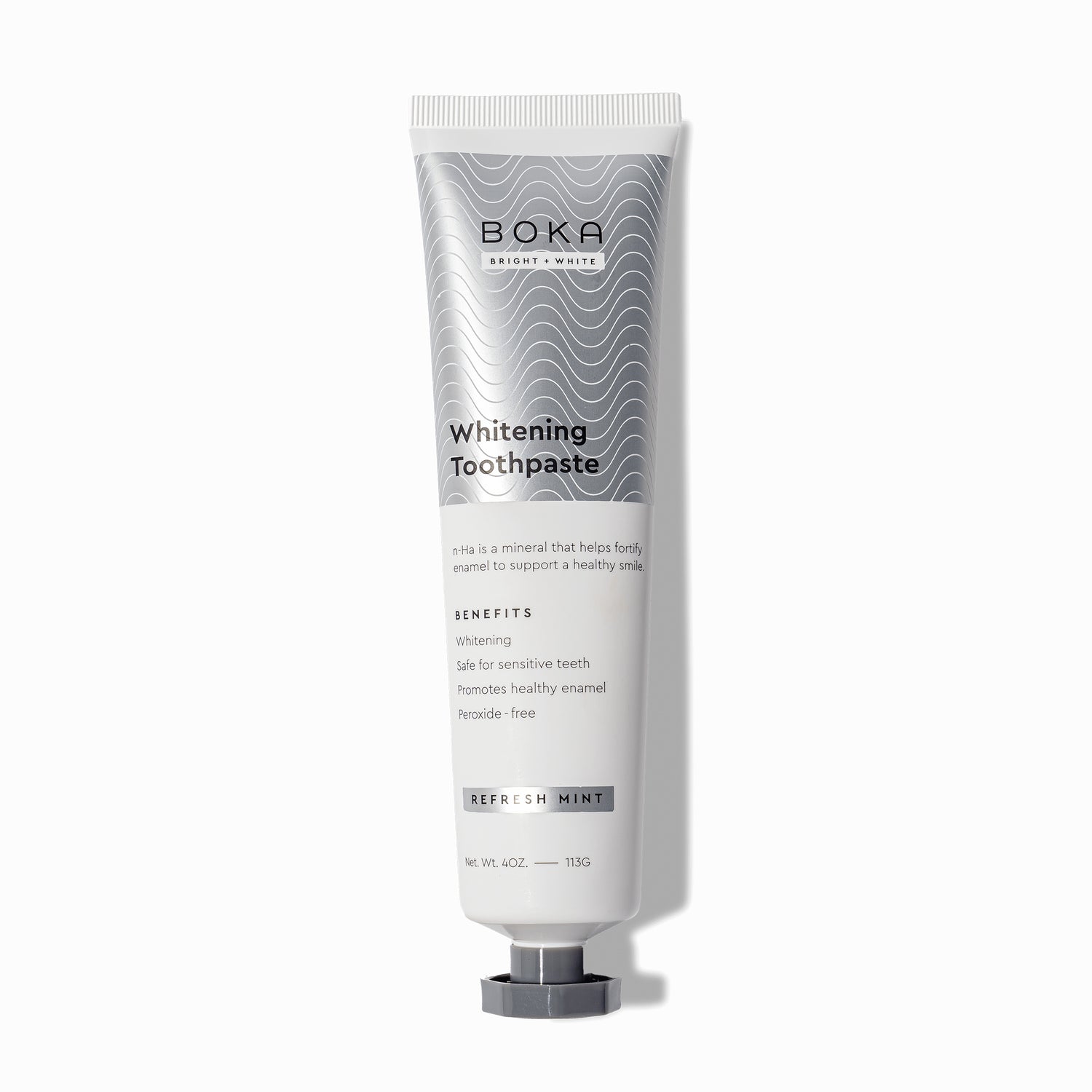Swallowing toothpaste is a common concern, especially among parents of young children.
After all, toothpaste is meant for cleaning the teeth and not for ingesting!
The primary concern when toothpaste is swallowed in large amounts is the fluoride content.
Fluoride, in excessive doses, can lead to a condition called dental fluorosis which affects the enamel of the teeth and causes changes in their appearance.
Most cases are mild, but it's important to be aware of the risks of fluorosis when considering the use of fluoride toothpaste by children under the age of six.
While small amounts of swallowed toothpaste are unlikely to cause serious problems in adults, it's still best to avoid consumption as much as possible.
In this article, we’ll explore:
- The common ingredients found in toothpaste
- What happens if you swallow toothpaste
- What you can and should do after swallowing toothpaste.
Let’s get into it!
Common Ingredients in Toothpaste
Toothpaste is more than just a cleansing agent for teeth; its various ingredients serve purposes that range from cavity prevention to ensuring a pleasant brushing experience!
Fluoride
Fluoride is the cornerstone ingredient in many toothpastes and is widely credited for preventing tooth decay.
When children and adults use toothpaste with fluoride, it helps to remineralize weakened tooth enamel, slow down the loss of minerals from enamel, and reverse early signs of decay.
Despite its benefits, it’s important to be careful when using fluoride-containing toothpaste as excessive ingestion can have adverse effects. Fluorosis, which results in the development of white or brown patches on teeth, can be brought on by consuming too much fluoride toothpaste.
Other Active Ingredients
Apart from fluoride, toothpastes comprise various other active ingredients:
-
Abrasives: Substances such as calcium carbonate or silicates are included for their ability to remove debris and residual surface stains
- Flavorings: Ingredients like saccharin and other sweeteners are added to enhance the taste, without contributing to tooth decay
-
Detergents: Compounds such as sodium lauryl sulfate create foam, which aids in cleaning the teeth by lifting particles away from the surface
-
Surfactants: When you brush your teeth, the toothpaste contains a substance called sodium lauryl sulphate (SLS), which creates foam. This foam helps the toothpaste spread evenly around your mouth and removes bacteria and debris. However, SLS may cause irritation or allergic reactions in some people. This can result in dry mouth or ulcers. For people who are already prone to canker sores, SLS could potentially make them worse.
-
Antimicrobial agents: Some toothpaste formulations include antimicrobial chemicals like triclosan or tea tree oil to reduce plaque and bacteria in the mouth. Although these components are typically harmless, some people may be allergic to them or experience irritation or allergic reactions.
- Titanium Dioxide: Because of its availability, affordability, and chemical inertness, titanium dioxide (TiO2) is frequently found in toothpaste. Its main function is as a pigment to give toothpaste opacity and brightness. But there are worries about its possible toxicity, especially in light of its recent discovery as a possible human carcinogen.
Each of these components plays an essential part in oral hygiene by providing a comprehensive clean and pleasant brushing experience.
Using toothpaste formulated with these ingredients typically helps maintain oral health. However, ingestion should be avoided as much as possible!
Potential Risks of Swallowing Toothpaste
Consuming toothpaste in any amount is not recommended due to the presence of fluoride and other chemicals designed solely for topical use on teeth.
Swallowing small amounts of toothpaste
Swallowing small amounts of toothpaste (especially by children who are still learning to brush their teeth) can lead to dental fluorosis in certain cases.
This condition results in changes to the appearance of tooth enamel in children 8 years old and under – a critical period when most permanent teeth are being formed. The child may also experience minor stomach discomfort.
Swallowing large amounts of toothpaste
In the case of ingesting larger amounts of toothpaste, there might be more serious health concerns, especially for young children with lower body weight.
The higher fluoride content can cause stomach pain, intestinal blockage, and more severe forms of fluorosis.
It can also contribute to long-term health problems if toothpaste is continually swallowed over a long period. Additionally, ingredients like sodium lauryl sulfate can also contribute to further gastrointestinal irritation.
What can you do when you swallow toothpaste?
Swallowing toothpaste can happen unintentionally, especially in children. The main concern when this occurs is the potential ingestion of fluoride, which can be harmful in large amounts.
The following steps can guide you through the immediate measures as well as when to seek medical help!
Immediate Steps
-
Rinse: If toothpaste has been swallowed, you should rinse your mouth thoroughly with water to remove any remaining toothpaste
- Assess amount: If only a small amount of toothpaste has been swallowed, there will typically be no noticeable effects and it’s enough to drink a glass of water or milk to dilute the fluoride in the stomach.
When to Seek Medical Help
-
Large quantity: If someone ingests a large quantity of toothpaste and is showing symptoms such as stomach pain or excessive drooling, it’s highly recommended to seek medical help immediately
- Children: With children, even smaller amounts can be more concerning due to their lower body weight. It's important to contact a healthcare provider if a child swallows more than what is typically used for brushing.
Preventative Measures for Safe Toothpaste Use
To mitigate the risks associated with swallowing toothpaste, there are certain practices that should be adhered to which emphasize correct product usage and quantity control.
Proper Toothpaste Dispensing
- For children under 3 years of age:
-
Use a smear of toothpaste the size of a rice grain
- For children aged 3-6 years:
- Use a pea-sized amount of toothpaste.
Supervision is key for children, as they are more at risk of swallowing toothpaste accidentally!
Adults should ensure that the correct amount of toothpaste is dispensed and guide children during the brushing process. It’s recommended that toothpaste tubes are kept out of children’s reach when not in use.
Considering the risks associated with fluoride ingestion, you may want to consider switching to fluoride-free alternatives like Boka's Nano-hydroxyapatite toothpaste!
Boka toothpaste utilizes n-Ha (nano-hydroxyapatite) to remineralize enamel, maintain healthy teeth and gums, and remove surface stains effectively.
Studies have shown that n-Ha can be as efficient as fluoride in protecting teeth without the associated risks if ingested!
Boka also offers specially formulated toothpastes for children, ensuring a safer brushing experience for everyone in the family.
Join Boka Tribe
Boka toothpaste is designed not only to clean teeth but also to support enamel health and maintain a balanced oral microbiome!
Boka's enamel-reinforcing compound is a staple, providing essential minerals. Meanwhile, natural ingredients ensure a gentle yet effective clean.
Each tube of Boka toothpaste contains ingredients that are carefully chosen to prevent any adverse effects even if accidentally ingested in small quantities.
We have always prioritized our customer's well-being, ensuring that the toothpaste is free from harsh chemicals and abrasives that could harm the teeth or the body.
With a commitment to non-toxic ingredients, here at Boka, we are proud to offer a toothpaste that is as kind to your body as it is to your teeth and gums!


